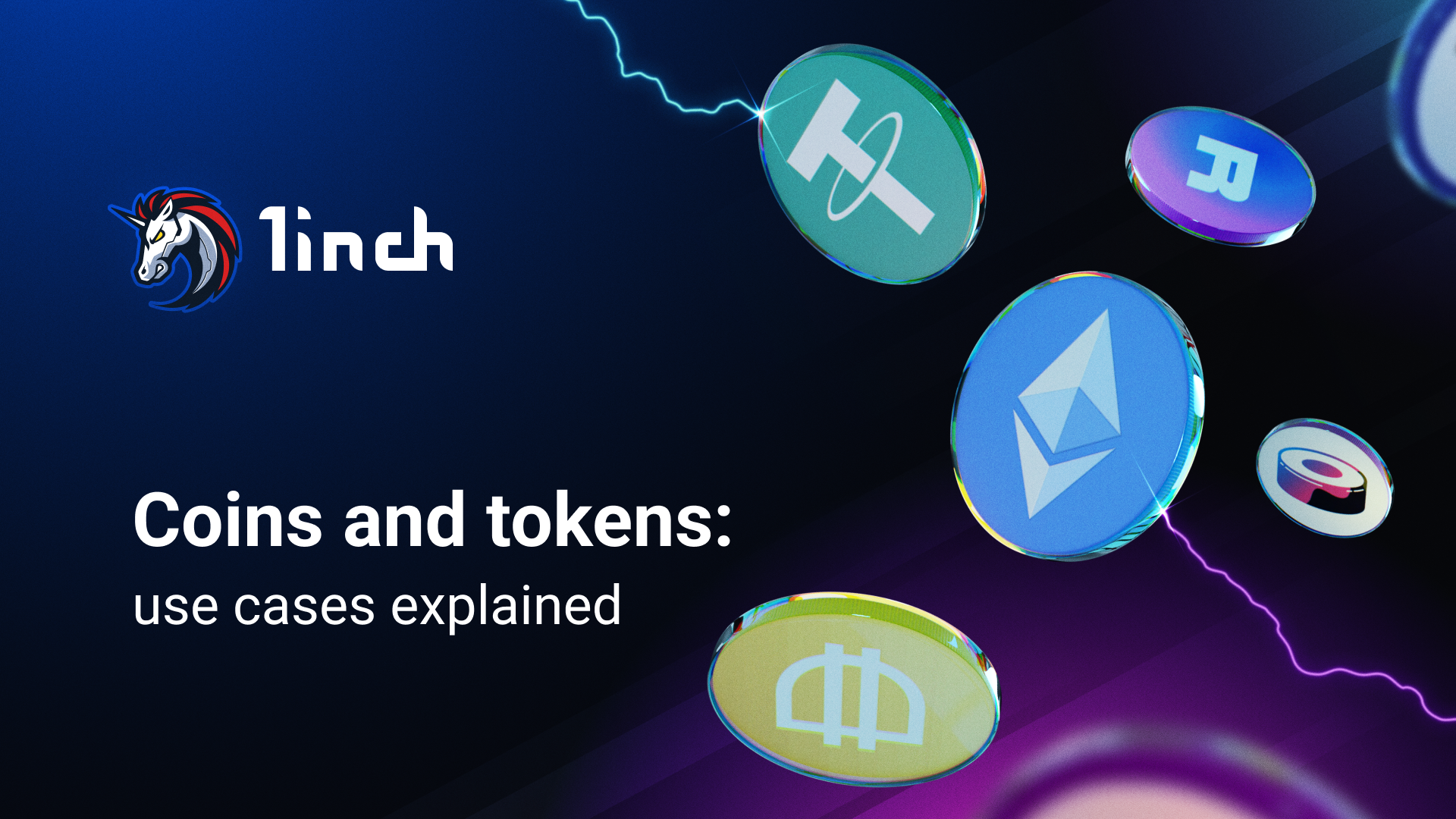What is the difference between tokens and coins?

While the terms ‘coins’ and ‘tokens’ are often used interchangeably, the former are primarily used as payment cryptocurrencies, whereas the latter have a wider range of applications.
Key takeaways:
The main types of crypto are coins and tokens. Although these terms are often used synonymously, there is a difference between the two. Сoins exist on their own blockchains, to which they are considered to be native, while tokens operate on other blockchains, such as Ethereum. Tokens (non-native tokens, to be precise, as native tokens do have their blockchain) are the units of cryptocurrency without their own blockchain.
Key features of coins
- Coins are issued on their native blockchains. They can be released through the process of validating transactions regulated by a blockchain consensus algorithm. Proof of Stake and Proof of Work are among the most common algorithms used by blockchains. Launching a new coin would require building a new blockchain first.
- Coins are designed to run on their blockchain. For instance, Bitcoin (BTC) operates only on the Bitcoin network.
- Native coins (native tokens) represent their blockchain. They can be used for network-specific use cases maintaining its ecosystem functionality, like paying transaction fees or issuing rewards. For example, for validating transactions on the Bitcoin network, miners are rewarded in the network’s native coin, BTC. And transaction fees on Ethereum (gas fees) are paid in the network’s native token, ETH. Also, ETH holders can use their coins to earn interest by staking them and receiving more functionality within the network as transaction validators.
- A coin’s value is influenced, among other factors, by the efficiency and security of the underlying blockchain.
These are some most widely-used coins and their native blockchains:
- BTC – Bitcoin
- ETH – Ethereum
- BNB – BNB Chain
- ADA – Cardano
- SOL – Solana
- XRP – Ripple
- DOGE – Dogecoin
Sometimes, the term “altcoin” (“alternative coin”) is used in reference to any coin other than Bitcoin (BTC).
Key features of tokens
- Tokens are created on top of other assets’ blockchains. A token can be issued on multiple blockchains. Tokens are released through minting and don’t depend on the transaction validation process. They are created on the basis of smart contracts, self-executed codes with terms and conditions stored on a blockchain. Ethereum was the first blockchain platform to introduce smart contracts and opportunities to create tokens and build crypto projects.
To launch a token, you just need to implement a smart contract using existing templates and deploy it on a blockchain. It enables crypto projects to issue their own tokens.
- Tokens can run on multiple blockchains. Just like the issuance, their transaction process relies on smart contracts. This allows for issuing one specific token on different blockchains supporting smart contract functionality.
- Tokens can have multiple use cases. Since they can represent crypto projects, tokens receive numerous functionalities inside them. A plethora of DeFi platforms have their tokens that perform various functions.
Utility tokens can serve as a key to services and opportunities provided by the issuing platform/dApp. Their holders can use them as an internal cryptocurrency within the blockchain project – they can be used for anything from paying for in-game items to ads depending on the platform’s focus. Holders can also receive rewards for different actions in utility tokens. They can benefit from earning interest through lending, borrowing, staking or farming and generating yield in utility tokens if they have value outside the platform. Many of those do have value and are successfully traded on exchanges. Utility tokens can be issued in an ICO and serve as a promotional tool for the project.
Governance tokens represent voting rights. Their holders can decide on spending budgets or adding new features to the project.
- Tokens can represent coins on other blockchains through wrapping. As coins can interact only with their respective blockchains, they need a mechanism letting them function within another blockchain ecosystem. After passing the wrapping process, a newborn wrapped token can act on the target blockchain as a native token while being tied to the underlying asset. For example, after wrapping, BTC (Bitcoin) becomes WBTC - wrapped Bitcoin, which can be transferred and stored on other chains.
- Tokens’ value can be pegged to the price of fiat currencies. Stablecoins are the type of tokens whose price is tied to traditional assets like the U.S. dollar or Euro.
- Non-fungible tokens (NFTs) can represent the ownership of digitized items. Each NFT differs in type and value from other NFTs and is therefore unique and not interchangeable. NFTs can authenticate their holders and verify their ownership of almost anything – the only condition is that the file converted into NFT should be digital. Those can be paintings, videos, music or any digitized document, including test results or real estate contracts. They are also commonly used in metaverses and games, confirming users’ ownership of lands or avatars.
- Tokens can serve as company shares.
Security tokens act as a digital form of traditional finance securities.
Equity tokens are one of their categories. They are similar to stock assets or bonds and can provide voting power. Such tokens are issued through an STO - security token offering or ETO - equity token offering. Unlike other tokens, security tokens are subject to regulation.
- A token’s price is influenced, among other factors, by the value of its issuing project.
Among some widely-used tokens are:
- USDT – Tether
- USDC – USD Coin
- DAI
- WBTC – Wrapped Bitcoin
- 1INCH
- SHIB – Shiba Inu
Token standards
Each blockchain network has a framework for issuing tokens – a standard. It determines a list of rules for tokens to interact with the network and functions, which developers must follow when launching new tokens. A token launched under a certain blockchain’s standard can operate on it.
The standards of the Ethereum network are ERC-20, ERC-721and ERC-1151, while the BNB’s is BEP-20, and Tron’s is TRC-20.
The same tokens can be issued and function on various blockchains due to being implemented in multiple standards. For example, USDT and USDC stablecoins can operate on various blockchains since they support various standards.
When transferring tokens within any network, you must check if moving tokens match the blockchain’s standard. You cannot transfer USDT of the ERC-20 standard within the Tron network. The incompatibility of cryptocurrencies of other networks’ standards with blockchains can be compared to the traditional financial world, where you wouldn’t use, for example, the Australian dollar in the U.S. as a means of payment.




























